Both edible and poisonous green mushrooms grow around the world. Often spotted sooner than other mushrooms with earthy tones in the woodlands, green mushrooms grow in a widespread habitat.
They are most commonly found in coniferous and broadleaf woodlands, including in North America.
Green mushrooms are also found in vast open grassland, next to roads or ditches, or even in gardens.
Often tasty but most commonly off-putting or even poisonous, green mushrooms are also common in Europe, Asia, and Australia.
Some of these mushrooms may also become green when bruised and may even stain. Many were used as natural dye back in the old days.
The following species of mushrooms are some of the most representative around the world. Some are more common than others.
Table of Contents
1. Green Wood Cup
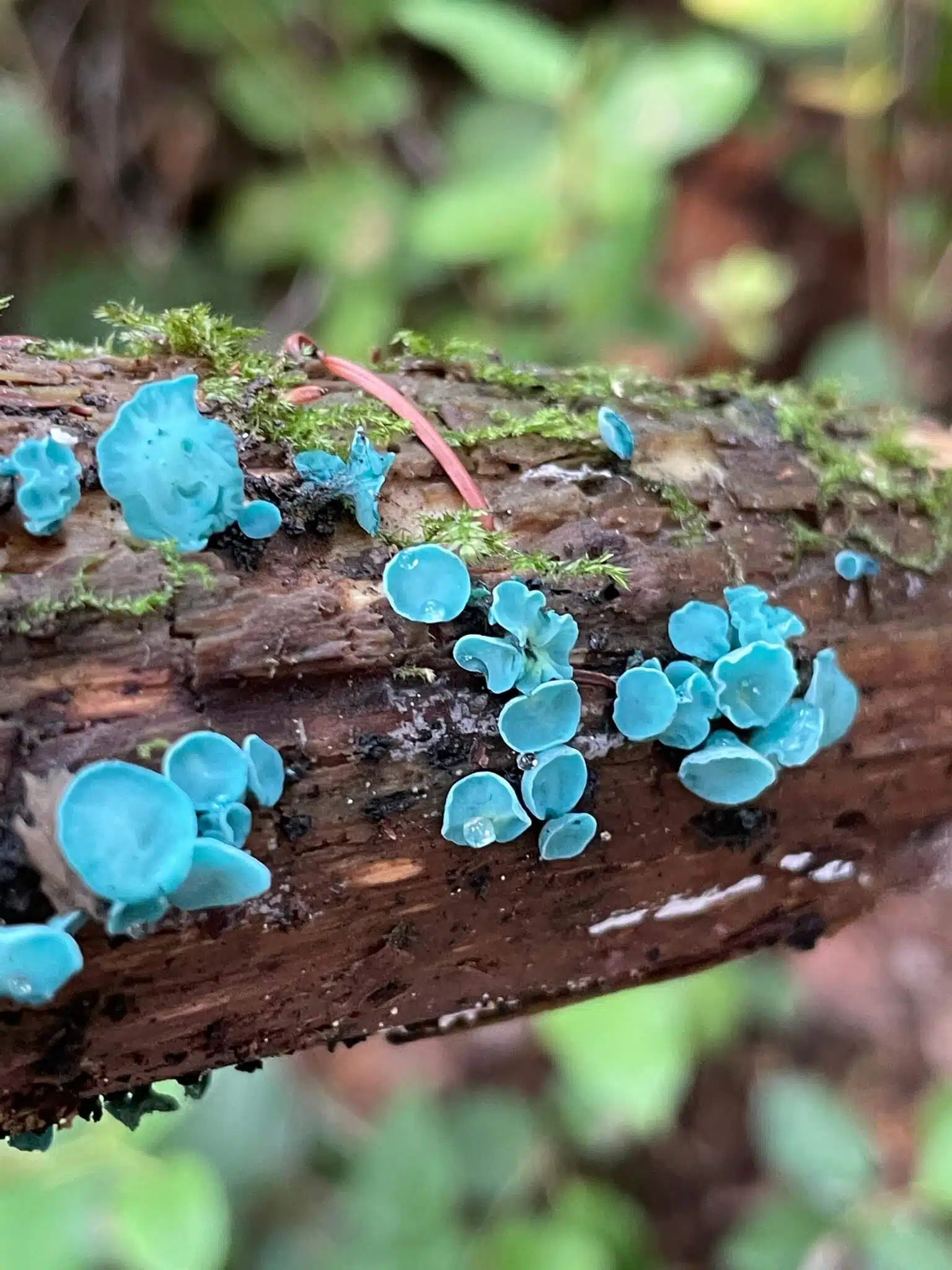
A vivid green nuance is specific to Green Wood Cup fungi (Chlorociboria aeruginascens), a species named after its cup-like shape.
Green Wood Cup fungi have an interesting growth rate where, in most cases, their fruit bodies develop in years.
Most types of Green Wood Cup fungi only appear as a stain on decaying wood. A type of painted-like green area on the wood marks their microscopic presence.
Fruit bodies of a similar green nuance may also arise on the decaying wood, typically in lower numbers and on rare occasions.
These fruit bodies also have a very short stipe, which isn’t visible.
Mostly seen as a type of wood stain, Green Wood Cup fungi were and still are harvested for their natural staining capacity.
Once harvested, they are used to stain woods such as oak.
Not all types of wood are appropriate for the fungi, on the other hand. The decaying process is typically more advanced on the wood these mushrooms grow on.
Only wood without any bark left is appropriate for the fungi.
As a result, the fungi tend to grow in the denser areas of the woodlands where multiple branches on or in the ground or dead trees have been decaying for at least a few years.
2. Mouse-pee Pinkgill
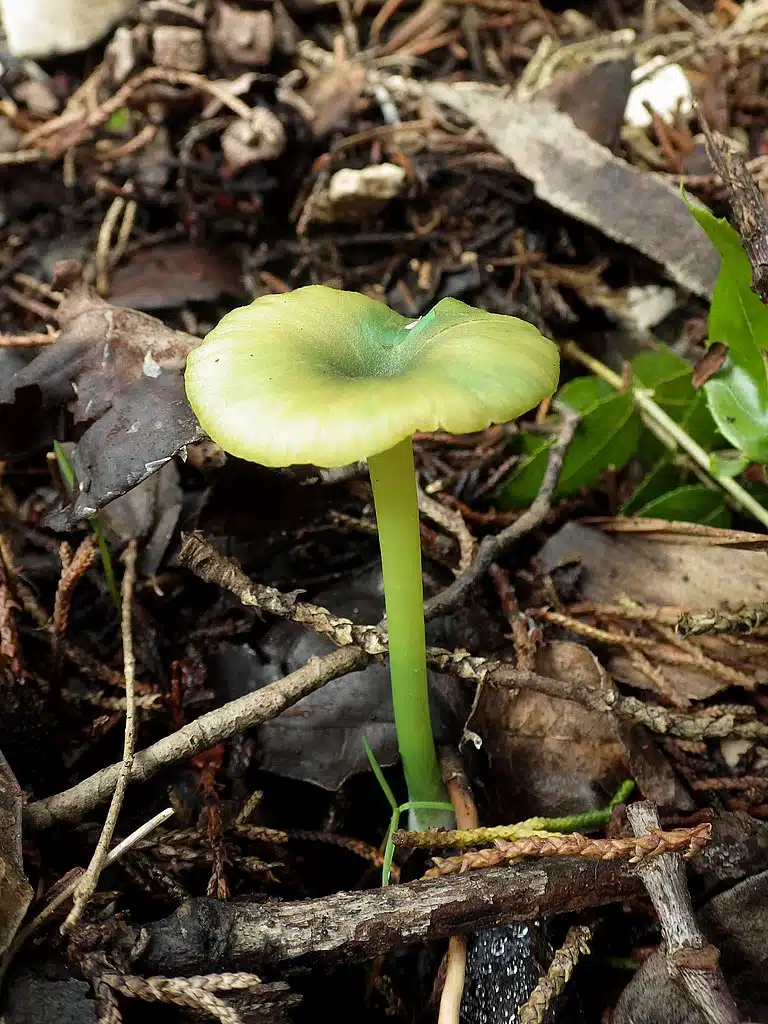
Mouse-pee Pinkgills (Entoloma incanum) are mostly found across Europe either in mixed woodlands or grasslands next to these woodlands.
Summertime in these temperate woodlands is when the species grows. It tends to grow in larger numbers on disturbed soils.
This is a type of mushroom with a differently-colored cap as opposed to the stipe.
Its cap has a yellow-to-tan nuance but it turns green once ripped.
A vivid green nuance is most commonly spotted on the stipe of these mushrooms. Darker green nuances are seen on the lower part of the stipe.
Mouse-pee Pinkgills are toxic mushrooms and they can’t be eaten.
Even more, their scent is highly off-putting. As their name implies, these mushrooms smell like mouse pee, an odor that projects up to several feet away.
Finding these mushrooms isn’t complicated at all due to their widespread presence.
They grow both in the summer and in the fall, covering vast territories and multiple US states.
They are found in all states of The Great Plains and are even quickly spread along roads and disturbed areas, apart from woodlands and grassland.
Its pink spores quickly spread along public roads or common paths on grassland or in woodlands.
3. Chicken Lips
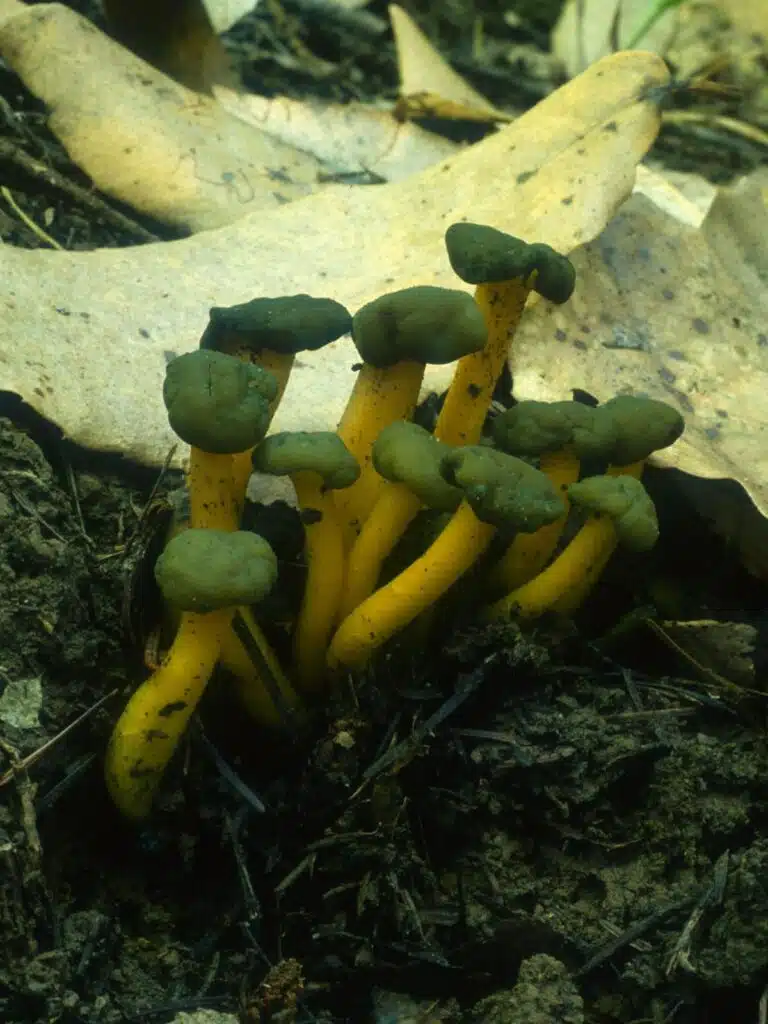
Chicken Lips (Leotia viscosa) are one of the more unusual types of mushrooms in North America. Mostly found West of The Rocky Mountains, this is a species with a high presence in California woodlands.
It prefers oak woodlands where it grows in small clusters.
On occasion, these mushrooms are also reported in coniferous woodlands.
Mushrooms of this species have a dark green cap with an irregular size.
The dark green nuance tends to become a dark emerald in its later growth stages.
A contrasting bright yellow stipe is further specific to these mushrooms which tend to stand out with a wavy stipe as well.
The taste of Chicken Lips is bad and these mushrooms aren’t picked.
Even more, they show a slimy texture which makes them a bit off-putting.
4. Verdigris Waxcap

While Chicken Lips are partly green, Verdigris Waxcaps (Gliophorus viridis) are all green.
These types of mushrooms show a bright green appearance with darker green stripes across the cap.
The stipe has a uniform bright green nuance.
Only growing to a height of up to 1.5 inches, Verdigris Waxcaps are named after their shiny and waxy texture.
A loss in color depth is noted with time.
Verdigris Waxcaps tend to become slightly brighter, especially on the cap, as they grow.
Specific to New Zealand woodlands, the species is reported in areas of dense woodlands.
They grow on the ground and are also reported in areas with decaying vegetation, also in broadleaf woodlands.
These mushrooms are believed not to be edible.
5. Gliophorus graminicolor
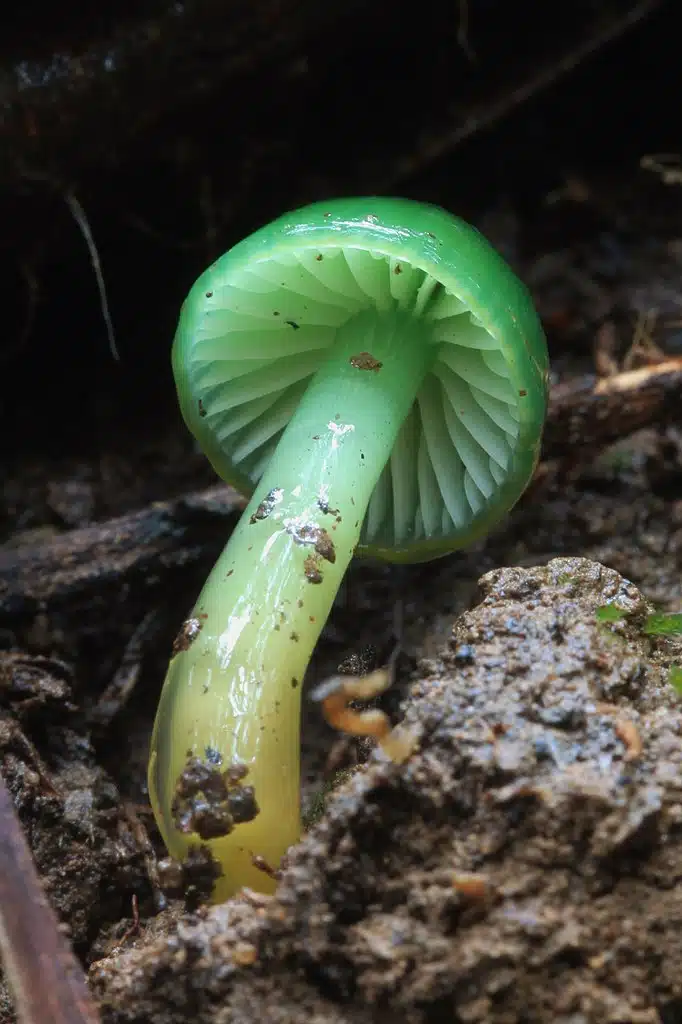
A similar species to Verdigris Waxcap, Gliophorus graminicolor is also found in New Zealand, but also in Australia.
This is a type of mushroom that grows in broadleaf forests and which has a changing pattern of green colors as it grows.
An initial darker green nuance is specific to both its cap and its stipe.
Darker green stripes decorate its cap but both the ground color and these decorative stripes tend to fade in time.
The cap of these mushrooms eventually becomes almost white, with a central round green spot.
Even the stipe itself becomes brighter and almost white.
Growing in large numbers in the ground, these mushrooms may reach a size of up to several inches but aren’t considered edible.
Even some of their variations that show brown patterns on the cap aren’t edible either.
6. Jade Pinkgill
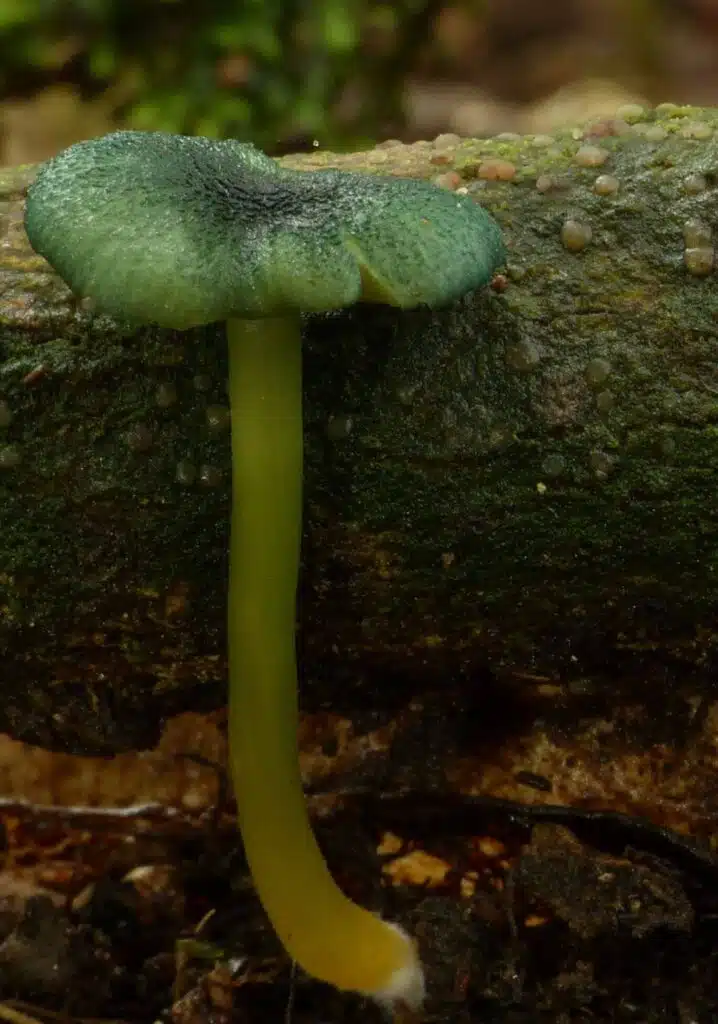
Found close to decaying wood in broadleaf and mixed forests, Jade Pinkgills (Entoloma glaucoroseum) have green caps and a green stipe.
This is a species with a specific jade nuance. This is a type of darker green that stands out on the forest floor.
Like a few other green mushrooms, the species tends to lose the vivacity of its jade nuance as it grows.
It can become slightly cream on the edges, solely showing a central green spot and green stripes on the cap as it grows.
Growing to more than 2 inches in height, the mushroom tends to maintain the green nuance of its stipe, on the other hand.
Further, distinguishing factors include white gills in their later growth stages.
Jade Pinkgills aren’t edible and are believed to be toxic according to some sources.
7. Green Russula
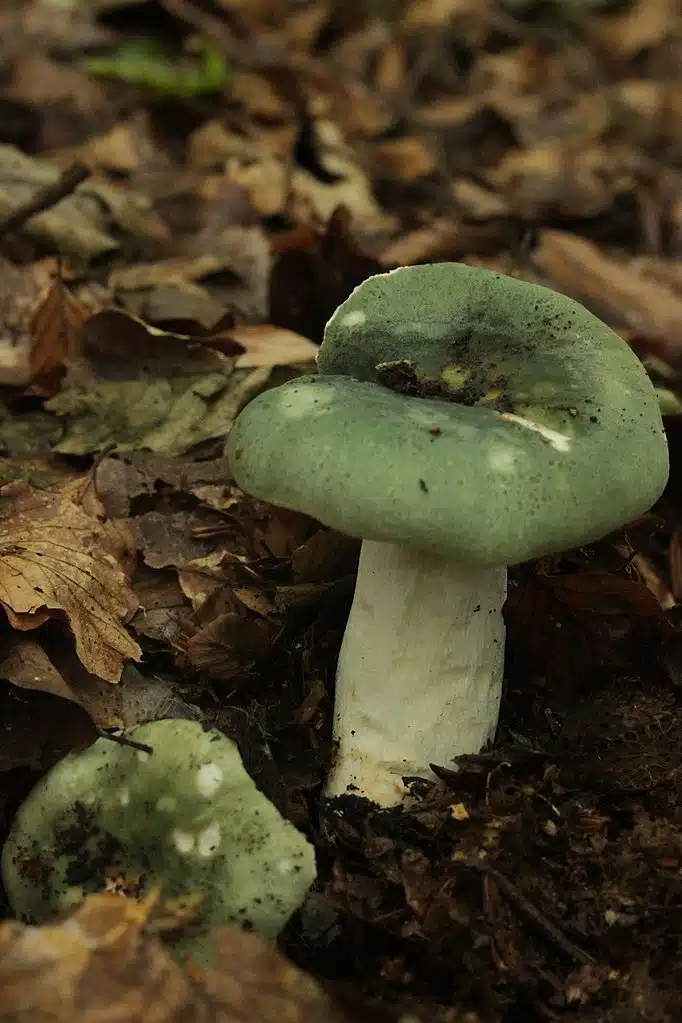
Green Russulas (Russula virescens) are some of the largest and tastiest types of green mushrooms.
They show a bright cap with a pattern of green dots of various shapes which may make it look poisonous.
Green Rusulla mushrooms have a rich nutty aroma and are consumed mostly in Europe and Asia.
This mushroom also grows to a diameter of up to 6 inches, making it one of the largest of its kind in the world.
The species is also present in Central America where it has adapted to subtropical forests from a more typical temperate forest habitat.
Its growth regions are still widely debated in scientific literature. By some sources, these mushrooms are strictly European.
Other sources claim they have a considerable presence in Eastern North America as well as in other parts of the world.
They are confirmed in subtropical areas of Asia as well.
Local markets in Mexico also sell Green Russulas early in the season and typically before the rainy season.
Some of the reasons for their popularity may include a high nutritional value. Green Russulas can be rich in iron and zinc they absorb from the ground.
Mushrooms of the species are found in oak woodlands in their highest numbers and can be collected at any time through the summer to be cooked or even eaten raw.
8. Green Brittlegill

A species of Europe and North America, Green Brittlegills (Russula aeruginea) are among the mushrooms of a brighter green nuance.
Moss green or grass green are the shades these mushrooms are mostly associated with.
They have a bright wide cap and a height of up to 3 inches.
Green Brittlegills show white gills which darken as the mushroom grows.
They grow in different types of woodlands, mainly next to pine and birch, and aren’t believed to be edible.
A rare sight in woodlands, Green Brittlegills may be edible in some areas where they grow, but not much attention has been given to them given they grow scarcely.
9. Parrot Mushroom
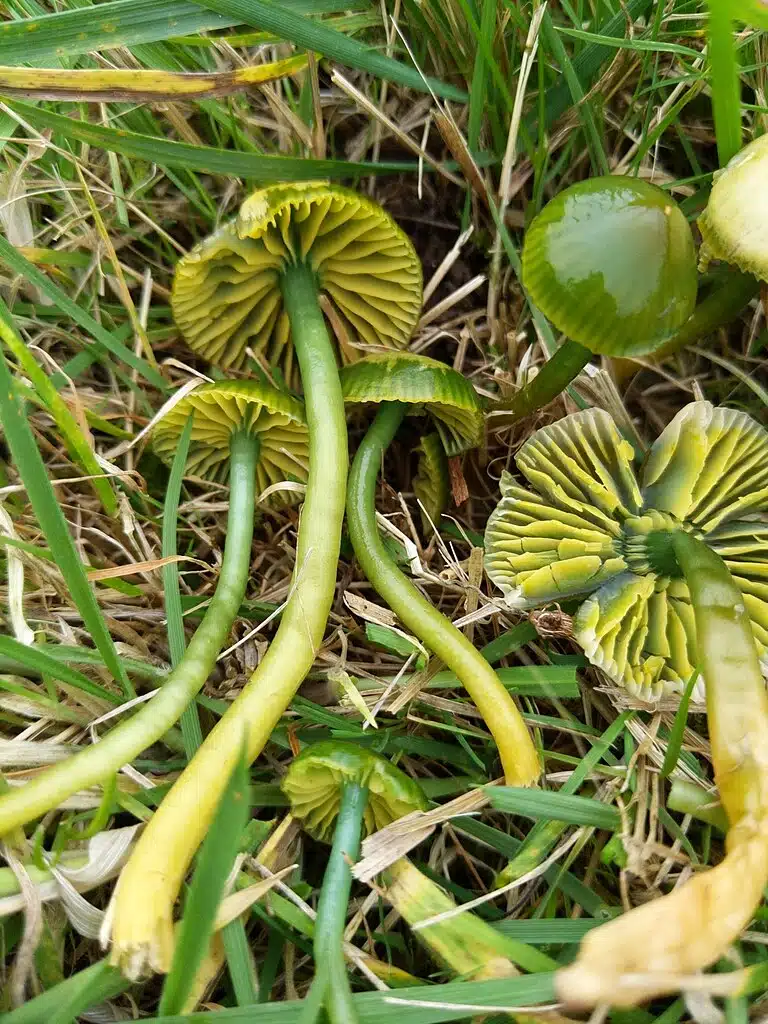
Mostly green at first, Parrot Mushrooms (Gliophorus psittacinus) represent one of the multiple species reported as edible by some and not edible by others.
It can be found in the forests of Western Europe and Eastern North America.
A dark green cap is specific to its early weeks and months. The species also shows a partly green stipe which is also partly yellow.
An overall yellowing of its appearance happens as this mushroom grows.
Its stipe eventually becomes yellow and it can also show a slight curvature under the load of a growing cap.
Parrot Mushrooms are among the species that grow late into the fall. In temperate climates, Parrot Mushrooms grow even up until late November and the first frost.
Its intriguing appearance has also led to its introduction around the world.
Parrot Mushrooms have also made it to Australia and New Zealand.
Some of its edibility reports come from outside Europe but the species is generally not seen as worthwhile as it grows scarcely.
Even more, the cap of Parot Mushrooms has a slime-like texture which is off-putting to most species.
10. Green Skinhead

Native to New Zealand and Australia, Green Skinhead mushrooms (Cortinarius austrovenetus) are among the species that grow to a considerable size.
A typical diameter of 4-6 inches makes the cap of these mushrooms some of the largest in the world.
The cap shows bright and dark green nuances, before becoming slightly brown as the mushroom reaches its peak growth.
The species shows a dark green central cap with bright green edges.
Yellow nuances dominate the stipe which is also known for growing flecks in the later growth stages.
Its natural range includes eucalyptus forests but the mushrooms aren’t as numerous as they don’t grow in clusters.
While large, these mushrooms should be avoided at all costs as eating them can lead to death.
The edibility status of the species is unknown but there are some suggestions to show the entire group of mushrooms it’s part of is deadly.
11. Aniseed Funnel

Aniseed Funnel (Clitocybe odora) are medium-to-large green mushrooms that grow in Europe and North America.
This is a species with a distinct green appearance. Dark emerald nuances form the central part of the cap while bright green nuances are seen across its margins.
Its gills become white as the mushrooms grow, together with the brightening stipe.
Aniseed Funnel mushrooms are named after their aniseed aroma. This is a species that tastes like aniseed even after cooking.
Frying and sauteing are some of the most common ways of cooking Aniseed Funnels.
These mushrooms aren’t readily available all over the world, on the other hand.
Aniseed Funnels are also among the few types of mushrooms that can be dried and turned into condiments, maintaining their strong aromatic profile.
Most of the mushrooms available for purchase are found in Europe and North America.
Their season starts in July and lasts until October. Most of these mushrooms grow in oak woodlands with occasional ones spotted in coniferous woodlands.
12. Lime-Green Waxy Cap

Some types of mushrooms have vivid green nuances such as the case of The Lime-Green Waxy Cap (Hygrocybe virescens).
This species is dominated by lime-green nuances both on the upper side of the cap and of the stipe.
The appearance of the cap changes slightly as it grows and flattens out. An additional yellow central section appears on the cap.
Mostly specific to The United States and Mexico, this is a type of green mushroom that grows in different habitats.
It has been traditionally associated with redwood and other hardwood trees.
Some exceptions apply in warmer climates such as those in Mexico. It turns out this mushroom can even grow on lawns here.
More commonly, Lime-Green Waxy Cap mushrooms grow next to cypress in Mexico.
Its edibility is still debated. While sometimes collected in Mexico, the mushroom is avoided in US forests due to its potentially poisonous status.
13. Green Stem Pinkgill

Green Stem Pinkgills (Entoloma rodwayi) have a very similar bright green nuance to Lime-Green Waxy Caps.
Both the cap and the stipe are dominated by either uniform green or combined green nuances.
The cap shows a base bright green nuance with additional dark green stripes that run from the center to the margins.
The stipe is thin and uniform green and may show a slight curvature under a larger cap.
As Lime-Green Waxy Cap mushrooms, Green Stem Pinkgills only grow to a maximum cap diameter of 1.3 inches.
Green Stem Pinkgills also represent one of the rarest types of green mushrooms with a presence limited to Tasmania and small forests in Australia.
This is a species that prefers humid forests but it grows scarcely, even in its native range.
Green Stem Pinkgills grow in high-elevation forests where snow can be present even during the summer.
Thick forests of Southern Tasmania are home to the species and the few trails along these tall forests provide a rare sight of the species which isn’t believed to be edible.
14. Turquoise Elfcup

A deep turquoise-green nuance is specific to Turqupose Elfcup fungi (Chlorociboria aeruginosa).
Only growing on dead wood, Turquoise Elcup sometimes grow their fruiting bodies to a cup shape that later flattens and grows in layers.
Even when the fruit bodies of these fungi grow visibly, they rarely reach a height of more than 0.3 inches.
Color changes are also specific to the fruiting body which can show a more green-inclined nuance on the top with the turquoise nuance being mostly specific to its underparts.
Growing on dead or decaying wood, this fungi initially appears in the form of a stain.
The dark green stain of the fungi grows along dead branches or hardwood logs.
Oak and hazel are among the types of dead wood the fungi favor and on which it appears in the form of a stain.
This stain rarely becomes a type of fungi with a visible fruit body.
Turquoise Elfucps are among the green species that favor late fall growth stages.
Specific to the forests of the Northern United States, these mushrooms are referred to as edible by some sources and not edible by others.
Even on the rare years they do grow, they are too small to pick.
15. Greasy Green Brittlegill

Greasy Green Brittlegills (Russula heterophylla) is a species mostly found in the woodlands of Europe.
It prefers the cooler Northern parts of the continent where it grows to a size of up to 3 inches in cap diameter.
Mostly green with a pale nuance, the mushroom may also appear in a few other colors, mostly shades of brown.
An ochre nuance is also specific to the cap of the species.
Greasy Green Brittlegills are considered edible and quite good.
The green cap and the white stipe can be cooked in various ways. Still, there’s the problem of incorrect species identification based on its resemblance to other poisonous mushrooms.
This means the Greasy Green Brittlegill may not be recommended for picking in its Britain and Scandinavian habitats.
Most commonly, the species is confused with Death Cap mushrooms which are so poisonous they can kill.
Ochre color variants and even purple color variants can help correctly identify Greasy Green Brittlegills.
As its name suggests, this is also a fragile species that takes very little effort to break.
Since its cap skin is often removed for frying, you need to pay attention not to easily break it yourself.
16. Green-staining Coral Mushroom
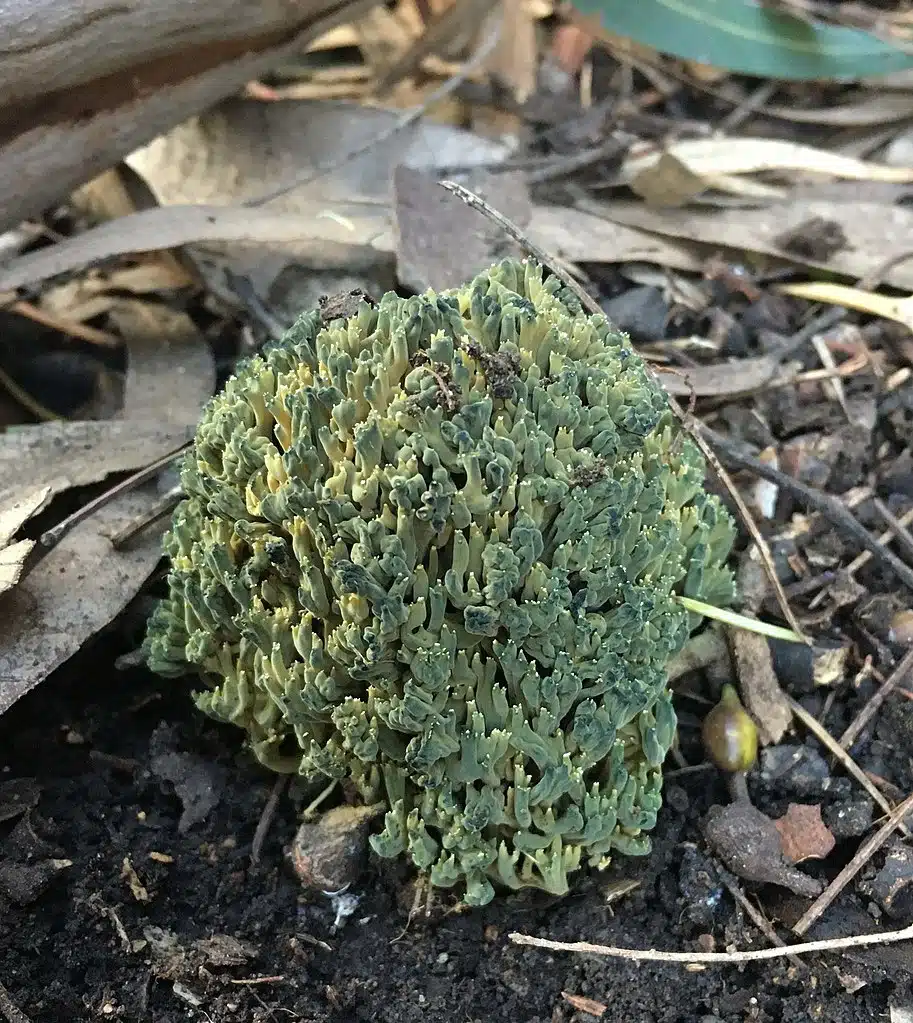
Coral mushrooms are named after they resemble actual corals and are types of fungi that typically grow on decaying wood.
A species present in coniferous woodlands, Green-staining Coral Mushrooms (Phaeoclavulina abietina) are mostly found in areas of Western North America, Europe, and Central America to a lesser extent.
This is a type of pale green coral mushroom, dominated by a rather olive color.
As its name suggests, the coral mushroom becomes mostly green when bruised.
Despite its rather large size and fruit body height, this species is not edible and should not be picked.
It reaches a fruit body height of just over 2 inches with a width of over 2 inches as well.
This type of coral mushroom is mostly associated with spruce trees, mostly with dead spruce trees in North America.
It also grows in mainland Europe but it’s not picked here either. Many stay away from it as some other types of similar-looking mushrooms are poisonous and deadly.
The tall mushroom has a long season which expands into November from mid-summer.
17. Green Earthtongue
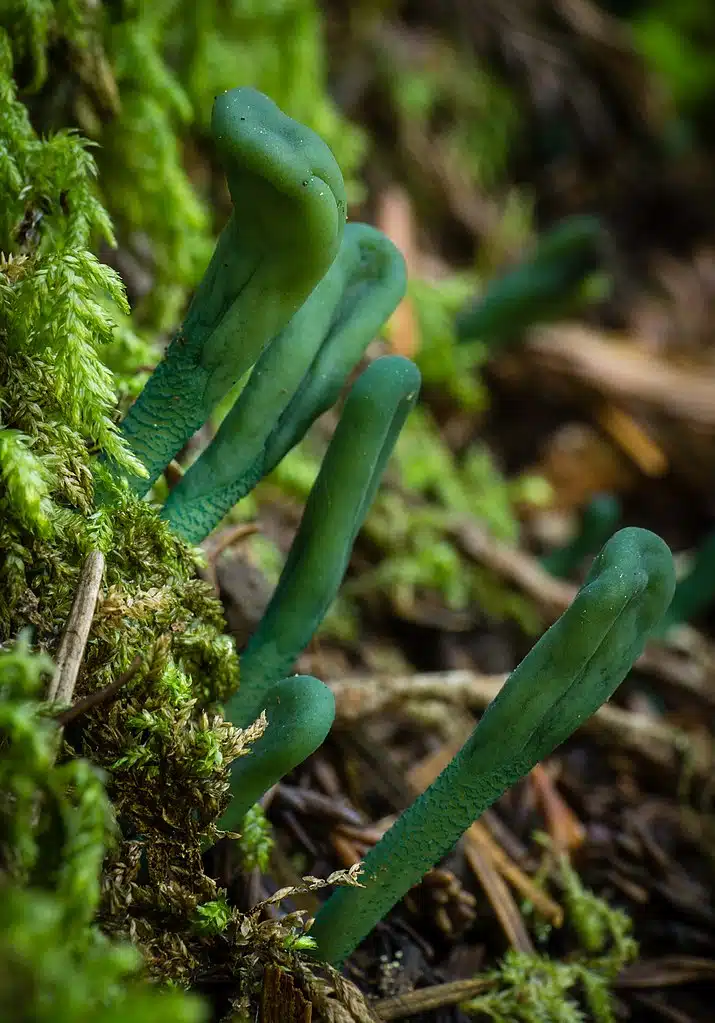
One of the rarest types of green mushrooms in North America is Green Earthtongues (Microglossum viride).
These types of mushrooms have elongated stipes and a short wide head that is supposed to resemble a tongue.
Various colors are specific to these mushrooms and include basic green, emerald-green, gray-green, and blue-green.
Color variation is high but it often includes at least a green part.
For example, these mushrooms may have a lower mint green color at first with an upper yellow nuance when young.
Broadleaf woodlands are a typical home to the species which is present on ground level, among the dead leaves.
They also grow in coniferous woodlands and may seldom be found in areas with mosses.
Mushrooms of this species are tubular but they rarely have a purely vertical shape. They’re mostly curved or they become slightly curved as they grow.
Their scarcity is well-known but some of the best periods to spot these mushrooms in the woodlands include the end of the winter and the beginning of the spring.